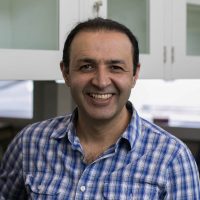
Ashkan Golshani
Professor
| Phone: | 613-520-2600 x 1006 |
| Email: | Ashkan.Golshani@carleton.ca |
| Office: | Office: 313B Nesbitt Building Lab: 311 Nesbitt Building |
| Website: | Visit my lab website |
Current Research
Keywords: functional genomics, proteomics, molecular biology, molecular genetics, microbial biology, anti-microbial/fungals
We are interested in identification of novel gene/protein functions in model microbial organisms such as yeast, Saccharomyces cerevisiae and E. coli. This area of biology is often called functional genomics/proteomics, which serves as a branch of systems molecular biology. The two main areas that we target are translation (protein synthesis) control and DNA damage repair, both of which have implications in important human conditions including progression and onset of cancer. We focus on pure research with some implication on the applied fields such as development of novel therapeutics. We use advanced molecular biology, molecular genetics and systems biology techniques and approaches for our research.
We are also interested in chemical-genomics of various natural bioactive compounds. There are 1,000s of compounds found in nature, which can perform various interesting functions in a cell. However, their biological implications at the molecular level have not been studied or realized. We perform systematic approaches to investigate the target site of some of these naturally occurring compounds.
We are also vigorously involved in computational prediction and design of protein-protein interactions (PPIs). We use computational approaches to design peptides that can bind and interfere with target PPIs and/or proteins. These peptides can be used to neutralize and/or detect specific targets and hence can be utilized in drug development and diagnostic approaches.
Selected Publications
Haji-Karimlou M, Moteshareie H, Omidi K, Hooshyar M, Shaikho S, Kazmirchuk T, Burnside D, Takallou S, Zare N, Jagadeesan S, Puchacz N, Babu M, Smith M, Holcik M, Samanfar B, Golshani A, Sensitivity of yeast to lithium chloride connects the activity of YTA6 and YPR096C to translation of structured mRNAs. PLoS One 2020;8;15(7):e0235033.
Hooshyar M, Jessulat M, Burnside D, Kluew A, Babu M, Golshani A. Deletion of yeast TPK1 reduces the efficiency of non-homologous end joining DNA repair. Biochem Biophys Res Commun. 2020;29:S0006-291X(20)31830-1.
Hajikarimlou M, Hunt K, Kirby G, Takallou S, Jagadeesan SK, Omidi K, Hooshyar M, Burnside D, Moteshareie H, Babu M, Smith M, Holcik M, Samanfar B, Golshani A. Lithium Chloride Sensitivity in Yeast and Regulation of Translation. Int J Molecular Science 2020;10;21(16):5730.
Dick K, Samanfar B, Barnes B, Cober ER, Mimee B, Tan LH, Molnar SJ, Biggar KK, Golshani A, Dehne F, Green JR. PIPE4: Fast PPI Predictor for Comprehensive Inter- and Cross-Species Interactomes. Scientific Rep. 2020;10(1):1390.
Galván Márquez IJ, McKay B, Wong A, Cheetham JJ, Bean C, Golshani A, Smith ML. Mode of action of nisin on Escherichia coli. Can J Microbiol. 2020;66(2):161-168.
Burnside D, Schoenrock A, Moteshareie H, Hooshyar M, Basra P, Hajikarimlou M, Dick K, Barnes B, Kazmirchuk T, Jessulat M, Pitre S, Samanfar B, Babu M, Green JR, Wong A, Dehne F, Biggar KK, Golshani A. In Silico Engineering of Synthetic Binding Proteins from Random Amino Acid Sequences. iScience. 2019; 11:375-387.
Ahmed D, Roy D, Jaworski A, Edwards A, Abizaid A, Kumar A, Golshani A, Cassol E. Differential remodeling of the electron transport chain is required to support TLR3 and TLR4 signaling and cytokine production in macrophages. Scientific Rep. 2019;9(1):18801.
Hernández RB, Moteshareie H, Burnside D, McKay B, Golshani A. Manganese-induced cellular disturbance in the baker’s yeast, Saccharomyces cerevisiae with putative implications in neuronal dysfunction. Scientific Rep. 2019; 25:6563.
Grigg N, Schoenrock A, Dick K, Green JR, Golshani A, Wong A, Dehne F, Tsai EC, Biggar KK. Insights into the suitability of utilizing brown rats (Rattus norvegicus) as a model for healing spinal cord injury with epidermal growth factor and fibroblast growth factor-II by predicting protein-protein interactions. Comput Biol Med. 2019; 104:220-226.
Babu M, Bundalovic-Torma C, Calmettes C, Phanse S, Zhang Q, Jiang Y, Minic Z, Kim S, Mehla J, Gagarinova A, Rodionova I, Kumar A, Guo H, Kagan O, Pogoutse O, Aoki H, Deineko V, Caufield JH, Holtzapple E, Zhang Z, Vastermark A, Pandya Y, Lai CC, El Bakkouri M, Hooda Y, Shah M, Burnside D, Hooshyar M, Vlasblom J, Rajagopala SV, Golshani A, Wuchty S, F Greenblatt J, Saier M, Uetz P, F Moraes T, Parkinson J, Emili A. Global landscape of cell envelope protein complexes in Escherichia coli. Nature Biotechnol. 2018; 36(1):103-112.
Galván Márquez I, Ghiyasvand M, Massarsky A, Babu M, Samanfar B, Omidi K, Moon TW, Smith ML, Golshani A. Zinc oxide and silver nanoparticles toxicity in the baker’s yeast, Saccharomyces cerevisiae. PLoS One. 2018; 13(3):e0193111.
Ahmed D, Jaworski A, Roy D, Willmore W, Golshani A, Cassol E. Transcriptional Profiling Suggests Extensive Metabolic Rewiring of Human and Mouse Macrophages during Early Interferon Alpha Responses. Mediators Inflamm. 2018; 5906819.
Bentley-DeSousa A, Holinier C, Moteshareie H, Tseng YC, Kajjo S, Nwosu C, Amodeo GF, Bondy-Chorney E, Sai Y, Rudner A, Golshani A, Davey NE, Downey M. A Screen for Candidate Targets of Lysine Polyphosphorylation Uncovers a Conserved Network Implicated in Ribosome Biogenesis. Cell Rep. 2018; 22(13):3427-3439.
Omidi K, Jessulat M, Hooshyar M, Burnside D, Schoenrock A, Kazmirchuk T, Hajikarimlou M, Daniel M, Moteshareie H, Bhojoo U, Sanders M, Ramotar D, Dehne F, Samanfar B, Babu M, Golshani A. Uncharacterized ORF HUR1 influences the efficiency of non-homologous end-joining repair in Saccharomyces cerevisiae. Gene. 2018; 639:128-136.
[top]